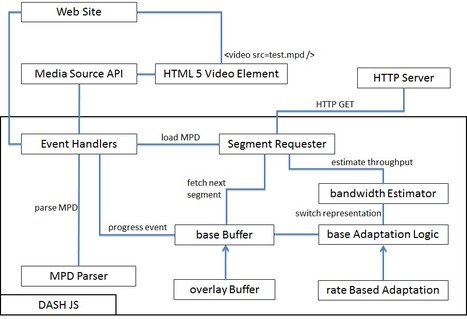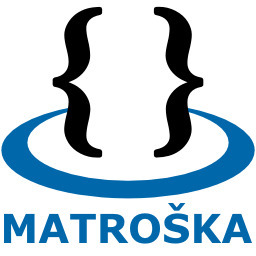 Your new post is loading...
 Your new post is loading...
One of the biggest video sites on the Net will use Google's next-generation video compression technology after it's fully defined on June 17. The VP9 bitstream definition, which describes how video is compressed into a stream of data so it can be transmitted efficiently over a network, has been in beta testing for a week, said Matt Frost, senior business product manager for the WebM Project. Paul Wilkins, a Google codec engineer, detailed the final schedule for the VP9 bitstream definition Thursday in a mailing list post. WebM will be updated to accommodate the new video codec and a new audio codec called Opus, too, said another Google employee, Lou Quillio.
Almost three years after Google released its WebM video encoding technology as a "free" and open alternative to the existing H.264 backed by Apple and others, it has admitted its position was wrong and that it would pay to license the patents WebM infringes. [...] Mozilla and Opera initially also tried to prevent the use of H.264, but have since capitulated to support H.264 as a standard, leaving Google's WebM in virtually the same position it had as a new 1.0 product three years ago, but without any excitement surrounding it. This essentially makes WebM the equivalent of Flash in 2010: resolved of legal challenges but saddled with technical and performance issues, and incompatible with any devices running iOS.
With Mozilla considering H.264 and Google refusing to drop it from Chrome, it seems unlikely that WebM will play a significant role in general-purpose streaming going forward. On a positive note, WebM did accomplish two useful functions. First, it wasn’t until after Google released WebM that MPEG-LA announced that free internet distribution of H.264 video would be royalty-free, and I doubt that would have happened absent the viable alternative that WebM promised. Second, WebM quieted all those annoying Ogg Theora promoters who fervently (and incorrectly) believed that Ogg was the future of HTML5 video. Beyond those two achievements, however, WebM is truly forgotten, though not quite gone.
A presentation by Benjamin Rainer, Stefan Lederer, Christophe Müller and Christian Timmerer. Summary : - Integrating WebM with MPEG-DASH - DASH in Javascript (DASH-JS) - Preliminary evaluation results - Showcases - Conclusions
DASH-JS is a seamless integration of the Dynamic Adaptive Streaming over HTTP (DASH) standard from MPEG into the Web using the HTML5 video element. Moreover, it is based on JavaScript which uses the Media Source API of Google’s Chrome browser to present a flexible and potentially browser independent DASH player. DASH-JS is currently using WebM-based media segments defined inthe Media Source API.
DASH-JS is a seamless integration of Dynamic Adaptive Streaming over HTTP (DASH) into the Web using the HTML5 video element. Moreover, it is based on JavaScript which uses the Media Source API of Google’s Chrome browser to present a flexible and potentially browser independent DASH player. Furthermore, DASH-JS is currently using WebM-based media segments and comes with a MPD generation script for WebM content.
VeriSilicon had an excellent year 2011 on promoting WebM, a free, open media format, and WebRTC, a free, open real-time communications framework, through Hantro video semiconductor IP licensing. Most tier-1 semiconductor companies adopted VP8 video format for WebM by integrating Hantro G1 Multi-format Decoder and Hantro H1 Multi-format Encoder, the only commercially available encoding IP supporting both H.264 and VP8, into their chips and platforms.
This enables WebM video in a number of new, exciting devices such as media tablets, smart phones and smart TVs. Under an existing licensing agreement with Google, VeriSilicon has rights to commercially license Hantro G1 Multi-format Decoder and Hantro H1 Multi-format Encoder products to semiconductor companies worldwide and modify the Hantro video IPs to enhance core architecture and add new features.
Hantro H1 Multi-format Video Encoder IP product page : http://www.verisilicon.com/en/products_hvip.asp
Google has released "Duclair," the new version 1.0.0 of its VP8 technology that the company says does a better job encoding video and faster job decoding it.
And it's a good thing, too, because VP8 is taking on not only the incumbent H.264, but also a sequel called High Efficiency Video Coding (HEVC) from the same group that's well under development.
Shaun the Sheep, An HTML5 Video Experiment
Watch Shaun and his friends' antics in clips from "An Ill Wind", "Snowed In", "The Big Chase", and "Twos Company" through an interactive experiment created with hardware-accelerated HTML5 video, 3D CSS Transforms, and WebM. Use the controls to expand and shrink the video, rotate the scene, bring up a rotating carousel of videos, turn on puddle reflection, and navigate between videos in a snap.
HTML5 and CSS make these advanced functionalities (and more!) a part of the modern web standard, and allow developers and artists to create immersive, imaginative experiences for everyone to enjoy.
Requirements:Windows Vista/Mac OS X 10.6 or above, Google Chrome
Until recently, the only way to embed video in web pages was using third-party plugins like Silverlight, Flash and QuickTime. HTML5 has made it easier to include multimedia in your web pages without any plugins, by just using the <video> element. However support for video and audio file formats varies across browsers. HTML5 capable browsers support different video formats.
Via Ludovic Bostral
Here’s a small nugget about Android 4.0, also known as Ice Cream Sandwich, that hasn’t gotten much play yet: The mobile OS now natively supports the playback of MKV files as well as streaming of Google’s WebM video format (hat tip to Richard Lawler). The changes were announced through an updated list of supported media formats on the Android developer website.
This document defines how to use Matroska/WebM with the MPEG DASH adaptive streaming system defined in ISO-IEC_23001-6. Excerpts : - A Media Segment in DASH corresponds to one or more Cluster in Matroska. - The Initialization Segment in DASH corresponds to the concatenation of the EBML header, Segment header, Segment Information and Tracks sections in Matroska. Files usually have these data at the front. Other level1 elements and some padding may occur in the Initialization Segment as well, except for Clusters and Cues. - The Index Segment in DASH corresponds to the Cues in Matroska. - A Sub-Index Media Segment in DASH corresponds to one or more Cluster preceded by a Cues that cover only these Clusters. It may also contain a SeekHead at the front with all the level1 elements found in that Sub-Index Media Segment. Cues and SeekHead are optional.
The rapid introduction and availability of the VP8 decoder for the ZMS processors highlights just how easily the performance of the underlying StemCell Computing architecture can be leveraged to support rapidly emerging industry standards such as VP8 and the WebM format. The optimized VP8 implementation takes full advantage of the programmability and performance of the ZMS processors' StemCell media array to deliver smooth playback of WebM content at resolutions up to 1080p.
Video : http://www.youtube.com/watch?v=Qn_gjsz87ec
|
Google's licensing agreement with MPEG LA, and while the impact on streaming is likely to be small, the implications may be significant for other technologies like WebRTC. [...] As always, Google’s profit motive for WebRTC is opaque. The best contender for an actual motive was proposed by Tsahi Levent-Levi in the VisionMobile blog, who opined, “The real value for Google lies in allowing them to serve more ads and mine more insights out of people’s browser behavior – these are things that Google treasures.” Whatever the motive, WebM certainly has a greater chance of succeeding in a nascent market like WebRTC than in existing markets that have already embraced other technologies.
Google has quietly started to switch some aspects of its premium content offerings to its open source WebM video format. Google’s WebM product manager John Lutherexplained during a developer Hangout Wednesday that YouTube and Google Play video rentals are now using WebM as opposed to Flash on Samsung’s Chromebooks. “We will be rolling that out on more Chrome OS devices and other platforms soon,” he added. Luther went on to explain that Google did a lot of work on the security layer that delivers the videos encrypted to an HTML5 player. “As far as I know, we are the first to ever do that,” he said.
The 2012 FOMS workshop took place in Paris, France. The working meeting consisted of focused sessions dedicated to bridging gaps among browser vendors and ensuing associative APIs meet the needs of developers that are making use of them. Browser vendors represented included Google Chrome, Mozilla Firefox, and Opera. Players platforms such as Youtube, BrightCove / VideoJS, Long tail / jwPlayer and of course Kaltura were also represented. Organised by Siliva, the meeting has long severed as a great space to hack and ‘get things done‘ in the open media standards and software space. This year was no exception. In this post I highlight some of the sessions that took place and provide a rough summery of the state of associated web video APIs & components : WebRTC, Media Source Extensions / MediaStream Processing API, WebVTT, New Codecs...
Matt Frost of the Chrome Web Media Platform team will demonstrate how HTML5 can achieve feature parity with Flash. It's less than one week until Streaming Media East begins, and HTML5 will again be a top topic for the two-day web video conference. Providing the opening-day keynote is Matt Frost, senior business product manager at Google Chrome. We spoke to Frost to get a preview of what attendees will learn during his address. For Frost and his team, building out HTML5 is a major priority.
Hardware product cycles are very long, especially from the software developer’s perspective. However, in just under two years after the launch of the WebM Project, the leading chip vendors are bringing to the market full hardware support for VP8 real time and streaming video decoding and encoding at 1080p resolution. In addition to the K3V2 application processor from Huawei and the RK30xx application processor from Rockchip announced at the Mobile World Congress 2012, ST-Ericsson has also finished developing a new platform with full VP8 support. “Working with the WebM team, ST-Ericsson is proud to demonstrate the first prototype devices using the NovaThor L954, a complete LTE platform for smartphones and tablets equipped with a high-performance application processor,” said Itai Dadon, Smartphone Business Development at ST-Ericsson. “The NovaThor L9540 incorporates a dual-core CPU, a powerful graphics engine and optimized multimedia accelerators in a high-performance, low-power solution which is fully geared for 1080p 30fps video playback of WebM on HTML5”.
Frank Galligan has been working on WebM VOD adaptive streaming for a while now, and posted instructions on how to create and playback a WebM adaptive presentation here.
General Notes:
- The player is written in JavaScript using Media Source API version 3.
- The manifest format is DASH using a proposed informative WebM spec .
- The player will switch video streams seamlessly.
- The current player only supports one audio stream.
Dominik Homberger has been very busy over the last few months working on porting first, Google’s WebP image format to JS and today launching his WebM video decoder in JavaScript. No, these are not Emscripten compiled versions - these are hand ports directly from the original C++ source code. And yes, both of these ports work in all browsers, not just the latest Chrome and Firefox - all browsers. The WebP port works in IE6+ with a flash fallback for the canvas element, as well as, of course, Chrome, Firefox, Safari and Opera and the mobile browsers on Android and iOS. The WebM video port works in IE9+, as well as all the other browsers mentioned before including the mobile ones. That is seriously impressive!
Online video is just plain hot. Marketers from all corners of the business world are combining clips with online venues like YouTube, Hulu and corporate Web sites to get moving pictures into the hands of existing and future customers. In May, Google heated up the online video space even more when it released its new open source, royalty-free video format known as “WebM.” Google’s newest addition is an outgrowth of its acquisition of On2, creator of the open-source format, which will soon be a part of Google’s popular online video service, YouTube.
Corey Lopardi, producer-director with Pardiman Productions in Olympia, Wash., says marketers will benefit from WebM’s release on several fronts. Lower production costs, ease of use, improved video quality and increased control over how videos are downloaded and viewed are just a few of the key benefits that companies could see. “This is definitely something that anyone wishing to market themselves online should be thinking about right now,” says Lopardi.
If you’re still not convinced of WebM’s impact, check out these five ways that the new format will alter the online video space...
For a while now I've seen people ask when support for Apple's Pantos HTTP live streaming would make it past Safari and iOS. The answer seems to have been that it wasn't clear that Pantos streaming was the best option and something else would come about eventually that would be more flexible. There have been other options but they involve either Flash or Silverlight and most people want something that works with html5 video. After a long wait it seems like the time is getting close now with the MediaSource API.
The basics of how the Pantos technique works are simple. A video is broken down into chunks and each of those chunks is downloaded, buffered and played. In older drafts this ment splitting a video file into multiple files but in later drafts support was added for range requests allowing the large file to remain intact. With that understanding there are two major parts that need to be addressed: - Segmenting a WebM video – This will require some understanding of the container format for WebM and the result will be something like a playlist for the video. - Javascript to play the video – This will use the playlist created by segmenting the WebM video to drive the MediaSource API.
See also : seeking with MediaSource API http://bit.ly/AyFssO
So, anyone remember WebM? A reader emailed me about a pilot study (in English!) performed by a collaboration between the NPO (the Dutch version of the BBC, basically) and TNO (the largest research institution in The Netherlands, often employed by our government) into the viability of using WebM and associated tools instead of H.264 and associated tools, including the perceived quality of VP8. The outcome of the pilot shouldn't surprise anyone - the toolchain needs work, WebM itself isn't there yet, but the future looks bright.
WebM is surely one of the hotest streaming topics right now, because WebM is one of the two final HTML5 video standards with H.264. When Google bought On2 in 2009 and open-sourced its latest VP8 codec one year later, two promises were made : providing a codec which quality can compete with H.264 , and providing it in a royalty-free way. On the quality point, the general opinion is that the VP8 codec is slightly less performing than H.264– but it can be an acceptable trade-off regarding the royalties point. Precisely, the royalty-free point is the one which raises the more questions now, as MPEG-LA is said to have a lineup of 12 patent owners ready to claim their rights on intellectual property, as VP8 would use compression techniques taken from H.264. Seeing their fight against Google being a success would cause a major setback in HTML5 standardization efforts around open source solutions – WebM then being another coding technology subject to royalties after H.264. Nevertheless, the patent war has not started yet and WebM is still a good alternative to H.264, on the paper. And that’s why we are curious to know how we can implement it in our existing or upcoming workflows. So let’s walk through the different steps of the WebM streaming workflow !
|



 Your new post is loading...
Your new post is loading...



























Official WebM announcement : "VP9 Codec Nears Completion" http://goo.gl/zLT8U